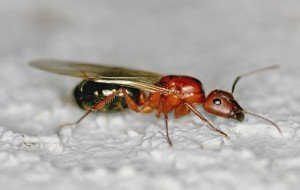Carpenter Ants: “What to Do” from identification, treatment and remediation of damage
With thousands of different types of ants in the world, carpenter ants are among the largest of the group. As the name implies, carpenter ants are associated with their burrowing and excavating habits in and around all types of wooden structures such as trees, homes, roofs, porches or decks. Similar to the wood loving habits of termites, carpenter ants differ as they do not eat the wood that they forage in. Instead, carpenter ants will give into their sweet tooth by enjoying a diet primarily consisting of sugar based foods and foods that are high in sugar such as fruits, plant nectars and juices. Out and about in their exterior habitats, carpenter ants are also predators and will feed on other insects. Although termites are known for their destructive habits of eating away at wood, carpenter ants boast a similar reputation and can cause equal damage by chewing and removing wood as they work to create tunnels to support their colonies.
In Canada in particular, the onset of the winter months does not provide much of a deterrent as ant colonies survive well in the cold and snow, making them difficult to get rid of. One or two carpenter ants in your home could be a sign of a more serious infestation, and it is important to address, treat and employ methods to prevent further damage. The carpenter ant’s superior excavation skills make them extremely difficult to access once they have tunneled their way inside of wooden structures. A professional ant extermination is always recommended as efforts may involve multiple treatments or services.
How to Identify Carpenter Ants
The most common carpenter ant found in Canada is the black carpenter, usually dark brown/black in color and ranging in length of ¼” to ½” in size. Divided into three segments, the head of the carpenter ant contains a pair of antennae that are bent while the abdomen tends to be bulbous in shape with long, yellow hairs. Chances are if you’ve spotted a large, black ant in your home, it is most likely a carpenter ant. While carpenter ants have powerful jaws, they seldom bite humans, instead using their strength to chew through wood.
Where to spot Carpenter Ants
Active all year round, carpenter ants can almost always be found near wooden structures with older homes being more prone to damage. Some places where you may spot these ants are:
- Openings in woodwork such as door or window frames. Carpenter ants chew through wood without eating it, and will always leave a trail of sawdust behind as evidence that they’ve been busy.
- Attracted to damp wood, if there are areas in your home prone to moisture, carpenter ants will make their way as the wood is easier to navigate. Around old door frames, bath tubs, sinks and roofs that have been affected by a leak, are all areas that you may spot these ants.
- Wood piles, decaying tree stumps or logs are also ideal spots for carpenter ants to take up residence and lay their eggs.
- Remember that sweet tooth? Your kitchen is the perfect spot for carpenter ants to enjoy spilt juice or open jars of honey or jam, as well as other food debris left lying around.
- Carpenter ants also need water to survive and will often find themselves near to areas that are moist.
Treatment approach used by Truly Nolen Canada
Aside from carpenter ants taking up room and board in your exterior living environment, they will also find their way indoors where food and water are more accessible. If you notice small piles of sawdust near wooden structures in your home, or if you’ve spotted several ants in one area of the house, it is a good idea to have your Truly Nolen professional on site to assess the situation. Upon a thorough inspection, your pest professional will be able to:
- Identify any nests inside or outside your home
- Assess and advise on the cause of any possible infestation (e.g.: Holes in foundations, heating ducts, windows or any wooden structure that is attached to the home)
- Incorporate bait products and treatments specifically designed to spread quickly throughout a colony of ants, thus allowing for control of the entire population.
Damage Control and Prevention
Although the treatment of a carpenter ant infestation can be a tricky process, there are steps that homeowners can take to help control and prevent carpenter ants from invading your home:
Exterior prevention:
- Store wooden elements (such as firewood) away from your home, making sure that they are not touching the exterior walls or garage.
- Seal any cracks or openings on the exterior of the home that could provide easy entry.
- Discard any moisture riddled debris and repair any moisture damaged wood.
- Remove any decaying tree stumps from your yard.
- Trim any overhanging trees and prune branches that may be touching your roof.
Interior prevention:
- Keep counter tops free of food debris.
- Seal cracked or leaking faucets, pipes or bathtubs.
- Store leftover food and packaged items in tightly sealed containers, including pet food.
- Avoid leaving grease or liquid spills in exposed areas.
As always, your Truly Nolen Canada professional can provide the best and most effective methods for getting rid of your ant problem, incorporating advanced Carpenter ant control techniques and providing outstanding service all year round.
